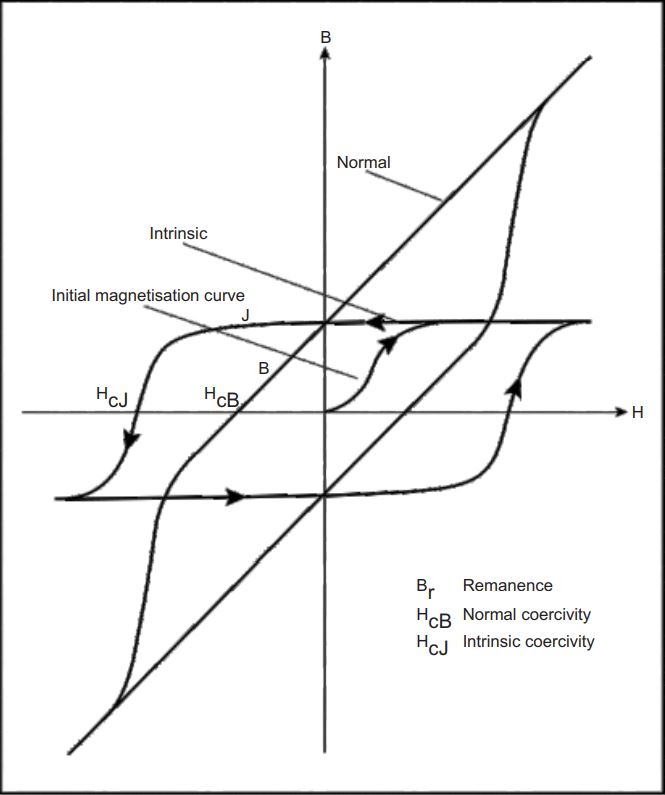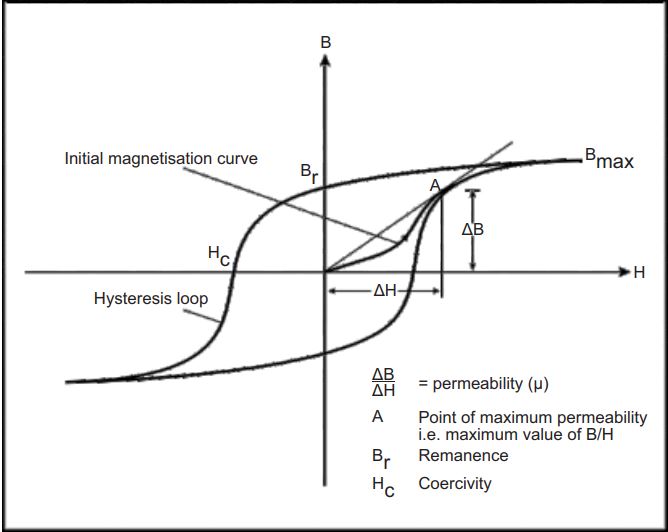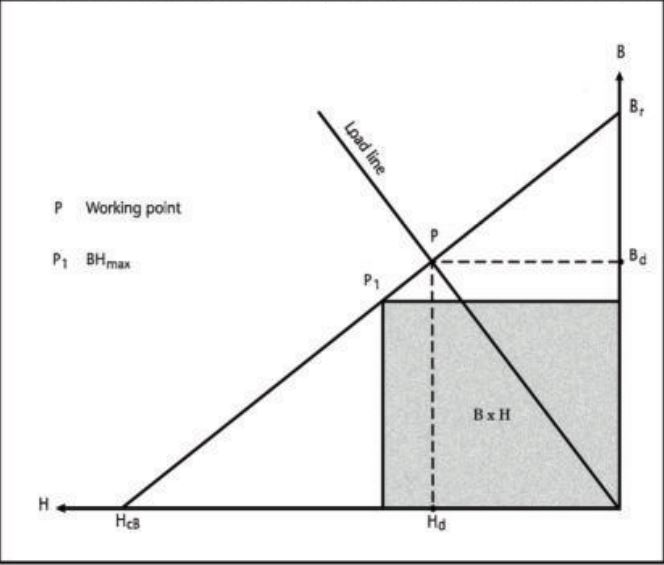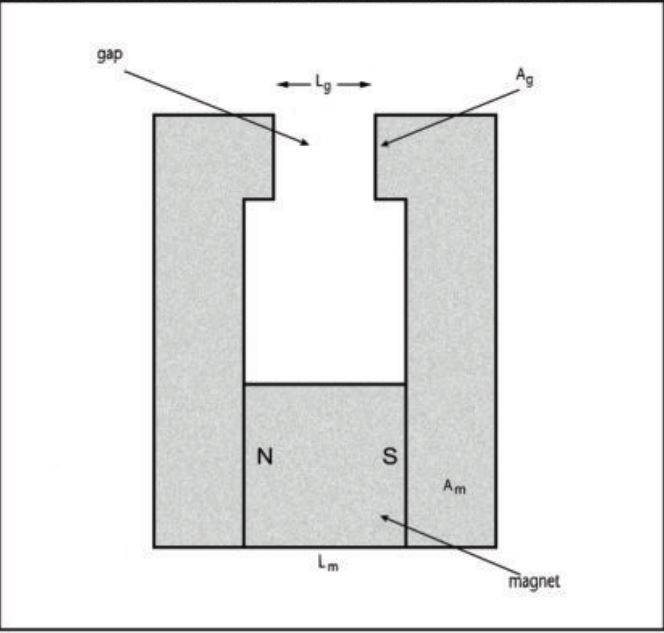All materials are defined as being magnetic in that they respond to the application of an applied magnetic field differently to that of air or vacuum. Only selected elements or alloys have useful magnetic properties in engineering applications. Magnetic materials which are easily magnetized and the magnetized are often termed soft. Conversely, those magnetic materials where any induced magnetism is difficult to remove are termed hard or permanent.
When a practical or highly permeable material is influenced by an external magnetic field it may acquire a large magnetization or magnetic induction. The level of the magnetization will be related to the individual intrinsic permeability of the material in question. The relationship between the external field in the induction is:
B = µH
where B is the magnetic induction and where µ is the permeability and where H is the external magnetic field.
In the S. I. system of units, B is defined in terms of the tesla (T) and the magneticfield H in ampere per meter (A/m).
When the external field, H and induction, B are identical (i.e. in a vacuum) the -7 permeability µ is exactly 4π x 10 in units of henry per meter for the equation to balance. It is termed µo . Hence:
B = µo H
In strongly magnetic materials the relationship is:
B = µo µr H
where µr is the relative permeability of the material.
B is defined as the total induction. It will comprise that from the externally applied field added to that of the strong internal magnetization. Hence the following relationship exists:
B = µo H + ȷ
where ȷ is the intrinsic magnetization of the material, also in tesla (T).
When magnetizing or measuring permanent magnets with high coercivity µo H as can be seen, ȷ has large significance. ȷ will define the ultimate stability of the magnet since it influences the coercivity Hcb and hence the linearity of a magnet. The temperature coefficient of the intrinsic coercivity Hcȷ is most often used with the temperature coefficient for remanence Br to describe the stability of a material.
In soft magnetic materials µo H is small compared to B (which is much higher than in permanent magnets). In the case of most engineering applications the hysteresis loop for ȷ vs H is practically identical to that for B vs H. In extremely high excitation fields ȷ and B are separated but this would not be expected in conventional electromagnetic devices.
Hard Magnetic Hysteresis Loop

Soft Magnetic Magnetisation and Hysteresis Curves

When considering magnet design an important aspect of the appropriate material choice is the working point of the magnet. This represents a point on the demagnetization curve of the B–H Graf and is determined by the geometry of either the magnet or the magnetic circuit.
By calculation, a line can be constructed which will have a defined slope and is known as the B/H, unit permeance to value or load line. The load line is drawn from the intersect where both B = 0 and H = 0 and continues until it crosses the demagnetization curve of the material. 49 Mobile design this point should be at or slightly above the BHmax in order to take full advantage of the material properties.
In most magnetic designs there will be a working gap with a magnetic flux will be performing a useful test. In order to determine a choice of magnetic material and perhaps the most suitable size of magnet it is useful to initially calculate the unit permeance line using the following formula:

The value of KI can vary over the range of 2 to 20 and can only be estimated correctly with experience. The value of Kr has a much closer range of 1 to 1.5 and for most purposes 1.35 is a good working figure.
2nd Quadrant B-H Curve

Schematic Permanent Magnetic Circuit

There are many considerations which influence the final design of a magnetic circuit but leakage flux and reluctance loss factors can have significant effects on the calculations made if estimated incorrectly. The choice of material is usually that which gives the highest flux density Bd for calculating unit permeance line where it intersects the demagnetization curve for a given material. These first principles of basic design often help derive the shape of a magnetic circuit which may be further optimized by computer-based numerical analysis.
Central in today’s modern industrial society are machines and systems which use electromagnetics to deliver effects such as force, motion, light, energy, communication and heat. In transportation, in industry and in the home, actuators and sensors player controlling part in the delivery of the ultimate requirements.
In many cases, the use of electromagnetics is replacing mechanical hydraulic systems. In some areas, the development of advanced magnetic materials and production methods even create new applications in themselves. As a consequence, the growth in the use of magnetic material is far above other normalized trends.
Advanced method used for product design and manufacture need strong and reliable inputs from manufacturers of sophisticated magnetic materials. Accurate design data and knowledge of the sensitivity to the environment enhance the success of products.
In a clear way this points to an increasing understanding of materials by designers and also an appreciation by magnetic material manufacturers of the demands of products in the manufacturing environment.
The list below shows some typical themed applications of magnetic materials and the related affect.
| Property | Application |
|---|---|
| Static forces exerted by or on magnets | Holding devices Thermostats Drives and couplings Clutches Reed switches Magnetic filtration Magnetic bearings |
| Electromagnetic forces | Loudspeakers Voice coil motors DC motors Synchronous motors Brushless motors Stepper motors Hysteresis motors Moving coil instruments |
| Electromagnetic induction | Generators Variable reluctance sensors Mechanical speedometers Microphones Eddy-current braking |
| The action of magnetic fields on the electronic structure of materials | Hall Effect devices Magnetoresistive sensors Giant magnetoresistive sensors |
| Magnetic resonance | Chemical analysis Body scanners |
| Forces on moving electrons and ions | Traveling wave tubes Arc suppressers Ion pumps Magnetrons Waveguides Circulators Cathode ray tube focusing |

